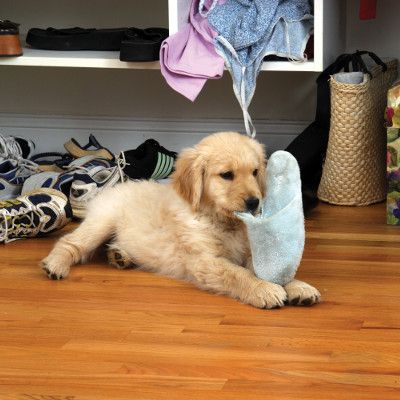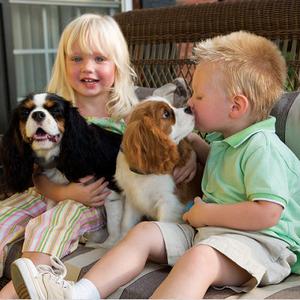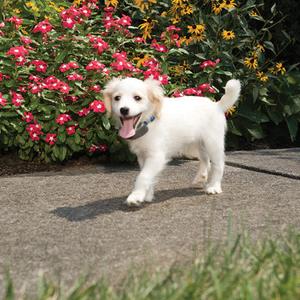You just brought your puppy home. You can help him become a stable, well-adjusted, behaviorally fit adult by spending a few minutes several times a day getting him used to the people, places, and things that he will encounter as an adult.
Your agenda should be to have him encounter at least 10 new things every day, both inside and outside your house. Some of these will be everyday occurrences - your hair dryer, a vacuum cleaner, opening and closing doors and drawers, hearing traffic, seeing squirrels, and passing people on the street. But some may not - dropping pots and pans, interacting with children, seeing a moving van, etc.
Your Puppy Can Leave Your House Before He's 3 Months Old
If your veterinarian has cautioned you against taking your puppy out in the real world before he has had all his shots, your vet may not be familiar with the latest advice. The American Veterinary Society of Animal Behavior recognized that more puppies are euthanized for behavior issues than medical ones and officially changed its position on the issue. Now they recommend that, "The primary and most important time for puppy socialization is the first three months of life.... It should be the standard of care for puppies to receive such socialization before they are fully vaccinated."
There are two areas to help in socializing your puppy - inside your house and outside. Environmental Enrichment provides your puppy with a multitude of experiences to see and do and interact with inside your house. Habituation helps him become comfortable about novel experiences both inside and outside your house.
Environmental Enrichment: Lots of Experiences in Your Home
Environmental enrichment in your house can generally be divided into 5 areas:
-
 Food-Based Enrichment - Hide food in boxes of all shapes and sizes.
Food-Based Enrichment - Hide food in boxes of all shapes and sizes. - Sensory Enrichment - Change the environment. Take the cushions off the sofa or stack them up.
- Social Enrichment - Invite some puppies and dogs over for a puppy party. Make sure they are healthy, vaccinated, and like puppies.
- Novel Items - Get a small step stool for him to climb on or over when he goes through a doorway. Block the doorway so stepping over it is the only way he can get through.
- Positive Training - Start some simple obedience exercises, such as Sit. You can do this even if you're watching TV. training sessions need to be short because of his short attention span, so you can train during commercials. While you're watching the program, keep him occupied with something to chew on while he is in his bed on the floor.
Habituation: New Experiences Outside Your Home
Habituating him to new situations outside is a little trickier because you don't have the control that you did inside. If you have a yard, use a wading pool and let him dive for floating toys, frozen treats, or even ice cubes.
-
 Plan carefully - and you do need a plan; it should not be haphazard.
Plan carefully - and you do need a plan; it should not be haphazard. - Do easy things first, make sure your puppy is comfortable, and then build on those experiences by making them more complicated.
- Take him with you wherever you go - to the bank, to get gas, to your friend's house. But be safe by carrying him either in your arms or - better yet - in a carrier or a puppy stroller.
- Take him for car rides and stop the car frequently and let him look at the world outside.
- Don't do too much at once. Let him explore at his own pace. Don't force your puppy into doing anything.
- Act the way you want your puppy to act. If you want him to be confident and happy, then you should act confident and happy.
- Be sure to match the situation you are introducing him to something he can handle. For example, if he's frightened of loud noises in your house and you've never taken him outside, then don't go where a motorcycle is roaring down the street.
- If he seems hesitant or unsure, let him go up to whatever he is concerned with at his own pace and retreat if he wants. Your job is to reward positive experiences with praise, petting, and treats as he gets close. If he will not eat treats, then he is likely too stressed.
- What may be okay for a confident puppy may be overwhelming for a shy puppy. His experiences should be fun and rewarding for him.
- Remember that he does go through Fear Periods. If you think he is fearful of something that he readily accepted yesterday, he may be experiencing a Fear Period.
- Try to make sure he's "empty," i.e., he has used the bathroom, when taking him to new places.
- Try to use food as a reward rather than a lure. o Use common sense where you take him, but don't be over protective.
Socializing with People: Set Some Ground Rules
And then there's interacting with people, including both adults and children. Be very specific and tell people how to interact with these steps.
-
 Slowly put your hand in front of his face.
Slowly put your hand in front of his face. - Let him smell your hand.
- Scratch him on his chest.
- Don't pet him on the top of the head.
- Only one person at a time.
If you would like a comprehensive free list of what to introduce him to, feel free to email me at caryl@PuppySocializationGuide.com.
You're on your way to helping your puppy become a behaviorally fit adult dog. Congratulations!







